
Hi Archinect!
I'm in Stubbins (a smaller room) tonight for a lecture by GSD Professor in Residence Iñaki Ábalos, widely rumored among students to be our next chair of Architecture. The lecture, entitled "Thermodynamics of mixed use high rise prototypes: theory and practice" will be introduced by professor Kiel Moe who will also present the recently formed Sustainable Design LAB.
6:37: Pre-introductions by student Carlos Cerezo, who is part of either the LatinGSD club and/or the GreenDesignGSD group, which are co-sponsoring the lecture.
6:38: Prof. Kiel Moe is introducing IA, who he describes as representing strengths in both theory and practice. If we follow IA's work--his technical and programmatic concerns, etc.--it becomes clear why he's interested in thermodynamics in buildings. IA and the options studios he's been teaching, represent an emerging research agenda within the school, with which KM will at times overlap. Evidence: the new book Thermodynamics applied to highrise and mixed use prototypes. This is a lecture tonight, but we're also being exposed to a research agenda.
6:43: IA thanks us for coming out on Halloween. The lecture will be a bit of a 'mixed salad.' These books represent the theoretical aspects of his work, over 25 years. Books develop even slower than buildings. Interest in time and space: time is the main preoccupation of philosophy, and space of architecture (but we're interested in both). Increasing interest in architecture in blending ideas from landscape and architecture, and in investigating the roots of the attraction to blend these categories.
Daniel Ibañez, the assistant for IA's options studio, helped prepare the book Thermodynamics applied to highrise and mixed use prototypes, based on that studio's work. "I love the...Swiss pharmacy look" of the book.
6:48: "I've brought some works that are very different, or similar, depending on the way we look at them." This project is in a suburb of Madrid; the history of this building is curious. It's an industrial city, where they store the products that come from the east, and it's very flat. The development has been "multiplied by 3" in the 25 years since then.
"The situation has changed drastically." The population here is 55% without jobs--a record in Spain.
"I became aware of these beautiful drawings of the 'heroic' period of modernism." I made this comparison--which is a joke--but it's not a joke. It's a serious thing. In the image from the left, from the communist Russian period, note the layers of industrial, residential, green program types alongside the river. On the right, a similar organization for the siting of IA's project. The center is a place to give people a sense that they belong to the city, that they have a role, and...obviously that they can re-educate themselves.
Then the authorities say to the architect --'we don't have money, it has to be really cheap, but it also needs to be monumental.' It's always this way. They wanted to produce an extension of the interior space, and an interior that literally mimics a factory. But the idea of how to use the space is completely different. "We had a problem that was not very well developed--they didn't know exactly what the needs of their people were." It didn't have any relationship with a medical center, or centers for the aged, etc. The organization is from south to north, with some patios in between, to cross ventilate the whole thing and have heat gains in the winter. Programs that generate more heat--like gyms--are oriented towards the north, and those that need more heat are to the south. And trees.
6:56: With this prototype or typology, it comes from typical Arab construction in south Spain--strips of roofs with some of the rooms having open patios. So there aren't corridors; it's a kind of labyrinth. The use of the rooms depends on activities, organized on a gradient of privacy, or depending on whether it's summer or winter. Another factor is the hearth; using a higher height and better insulation than normal in the roof. Efficiency, but also dignity for the space.
"I don't want to be deterministic; we don't have a religion called sustainability or thermodynamics. We believe in history, in memory." The community center project started with an earlier project that couldn't be realized, a house for a gallerist--a lady who lives alone with many paintings. "The construction is minimalist, in the economical sense of minimalism, not just the figurative sense."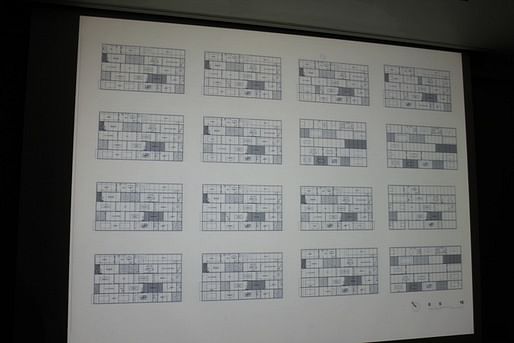
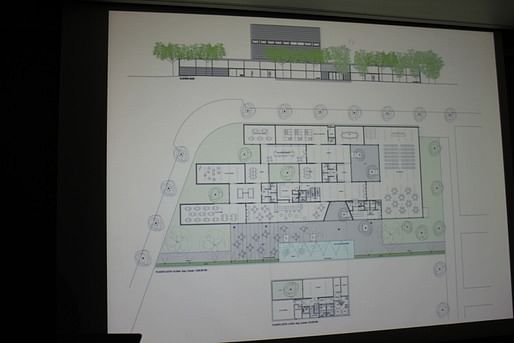
The glass facade is a collector of sun in the winter, whereas the activities take place outside during the summer, covered by the shades. Mention of use of photovoltaic panels and vertical ventilation shafts. It's completely industrial--we use cheap finishings--"wood..well, today we call it wood, it's an incredibly thin (veneer)."

 The strucutral tubes (above) also hold the glazing.
The strucutral tubes (above) also hold the glazing.

Space for watching soccer and dancing. "They're around 50 or 60 years old and they have a lot of parties. Every day." All the elements are repetitive to make the construction as cheap as possible, but with dignity. The roof--the only way to organize the garden with some kind of pattern was to lay out these lanes.
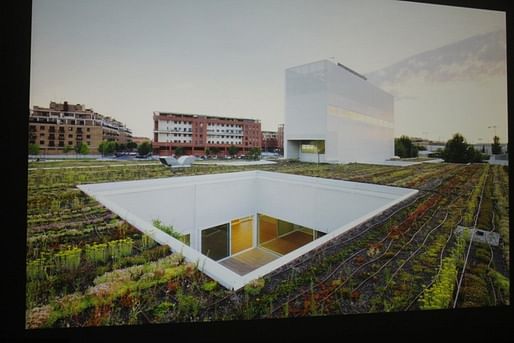
7:05: Tàpies Foundation, Barcelona. "In this case...the building was functioning before we arrived, but had a lot of problems...fire escapes, etc." They needed a stair (seen below), and wanted to transform and give visibility to the building.
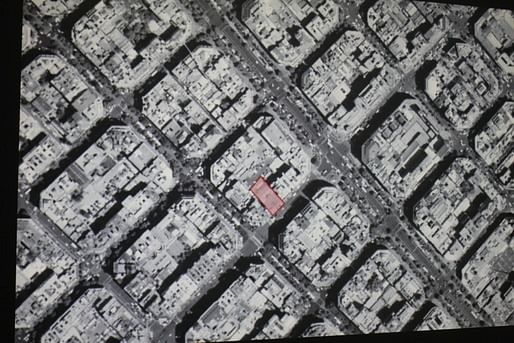

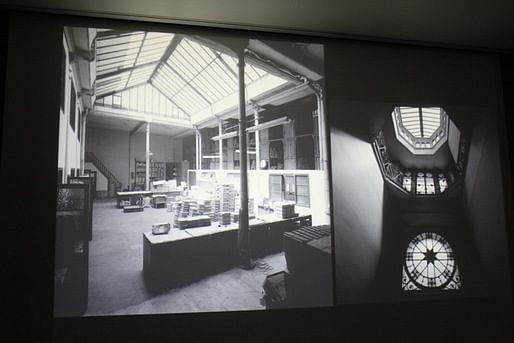 The building had housed a famous printer, and was the first industrial building in this particular urban fabric. A loft. There was a well-known intervention from the mid-80s, with a "plethora of postmodernism." "I was visiting this building; I thought it was interesting in those days. Culture evolves." We have to understand how and why it evolves. When he came back, colors and materials--everything was hidden: the changes in the years since the beautiful work in the 80s had no sense.
The building had housed a famous printer, and was the first industrial building in this particular urban fabric. A loft. There was a well-known intervention from the mid-80s, with a "plethora of postmodernism." "I was visiting this building; I thought it was interesting in those days. Culture evolves." We have to understand how and why it evolves. When he came back, colors and materials--everything was hidden: the changes in the years since the beautiful work in the 80s had no sense.

By destroying the intervention of the 80s, IA realized that he could fulfill 4 of the 5 pages of requirements. The original building was very good.
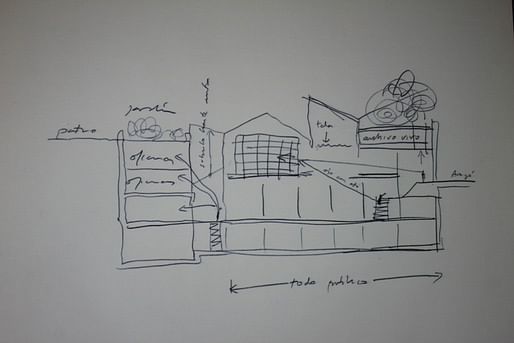 Original concept sketch--programmatic concerns, natural light. It was a historical building but also a statement about how a museum should be nowadays. You could see--or at least have glimpses--of all the functions and departments of the museum, from the galleries to offices, and archives.
Original concept sketch--programmatic concerns, natural light. It was a historical building but also a statement about how a museum should be nowadays. You could see--or at least have glimpses--of all the functions and departments of the museum, from the galleries to offices, and archives.
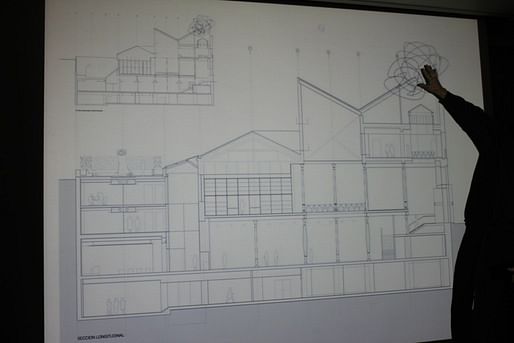
 1980s state (inset image, above)--fake bronzed painted columns, with air conditioning ducts making Greek references.
1980s state (inset image, above)--fake bronzed painted columns, with air conditioning ducts making Greek references.
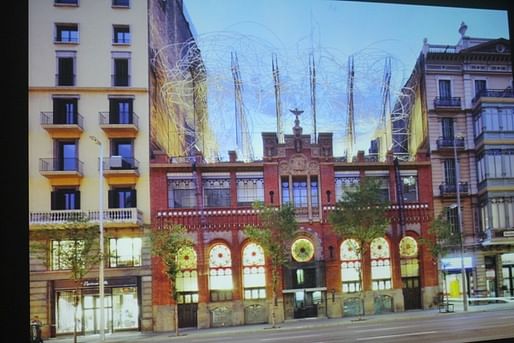 Beautiful cloud intervention on the roof. Intervention on the facade was minimal--cleaning, etc.
Beautiful cloud intervention on the roof. Intervention on the facade was minimal--cleaning, etc.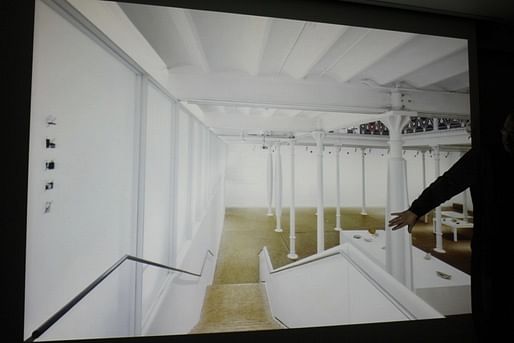
Columns were made minimal according to their shape. Hypostyle type space. Left the skylight.
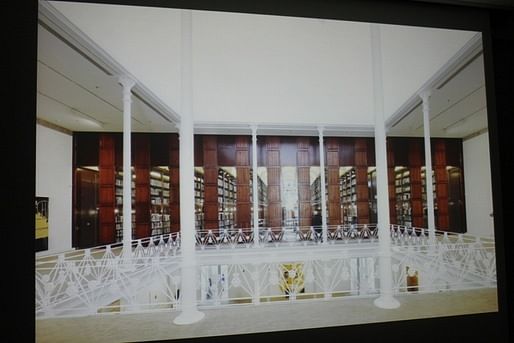
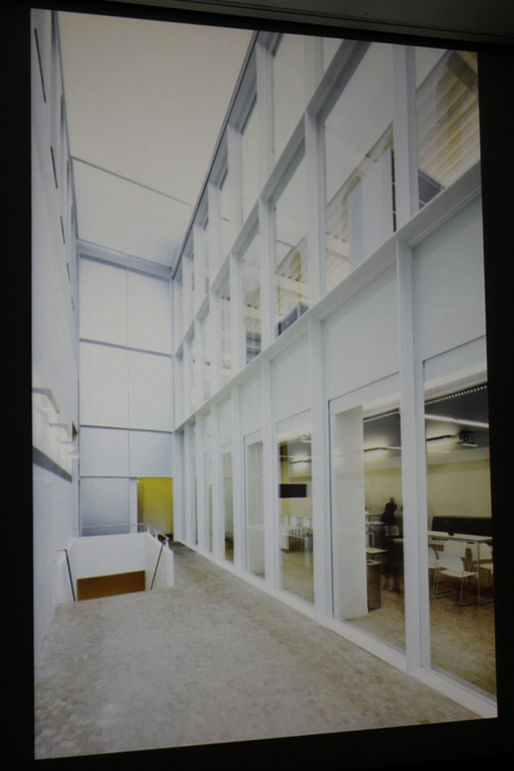
Little patio--the columns mimic the original structure, not because he wanted to so much as for structural reasons. In terms of economy, it's the most simple construction system you can have, but with a strong relationship with the existing fabric.
 At the top of the pavilion, access to a roof garden. Tàpies wanted to use this sculpture which had been a scandal when it was original made several years before. "The patios are something I love more about Barcelona...they are full of real life," surrounded by facades of other buildings.
At the top of the pavilion, access to a roof garden. Tàpies wanted to use this sculpture which had been a scandal when it was original made several years before. "The patios are something I love more about Barcelona...they are full of real life," surrounded by facades of other buildings.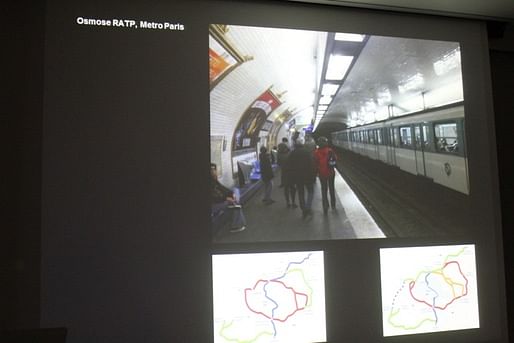
7:16: Osmose RATP, Metro Paris: They had commissions in Paris, London, and Madrid. "It was a very interesting exercise, mainly because in Paris the infrastructure is not just...belonging to the engineers. Historically all the interesting architects made interventions in the metro, and it's part of the patrimony of Paris."

The company wanted some return on their investment, and to give a new idea of what a metro station should be. The only thing that changed technically is that they're planning to protect the tube with another tube so that nobody can fall down. "This increases the efficiency of the metro incredibly, because a lot of people fall down." In Paris...they are drunk. And the environmental situation changes.
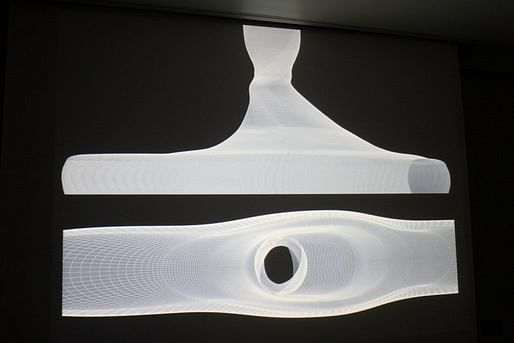
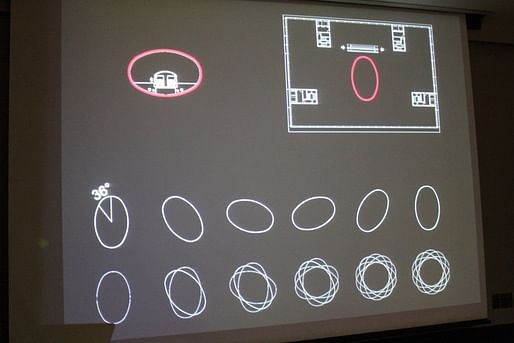
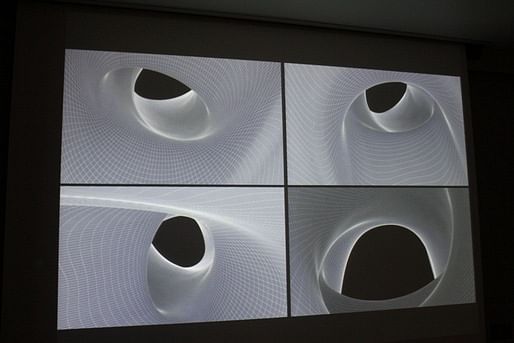
The idea was to establish a new relationship between the tube and the exterior atmosphere. They had the idea of wrapping a building around the tube--thinking of the metro as a big geothermal infrastructure. Use it to establish a prototype that...helps us to begin thinking about zero emissions--a fantasy of politicians in Europe. They worked with Jasper Morrison. The project aims to retain qualities of traditional metro stations while evoking something of the atmosphere, and air movement.
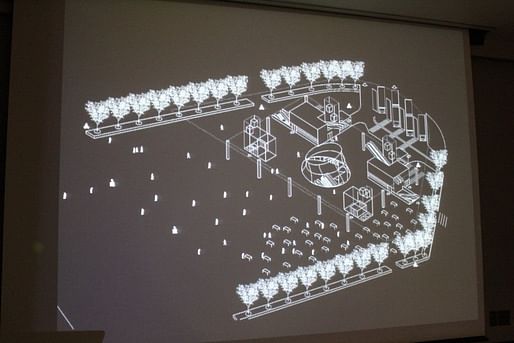
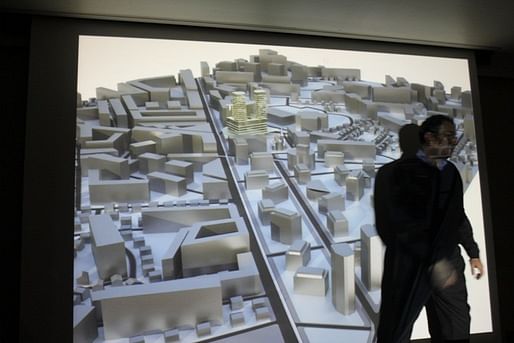
 The tube wraps inside a mixed-use building--residential and office.
The tube wraps inside a mixed-use building--residential and office.

It has some photovoltaic brise-soleils, "and all these gadgets." They used very simple technologies--heliostats that are programmed to bring down the sun when the metro is very crowded. And a way of dealing with heat gains off the facades of the towers.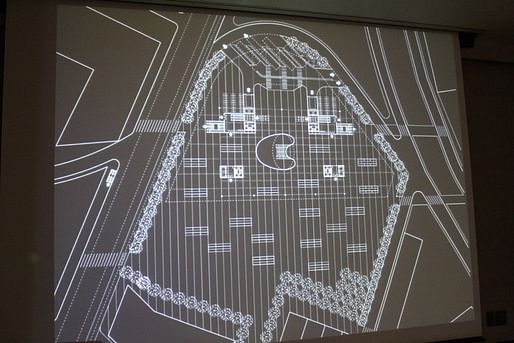


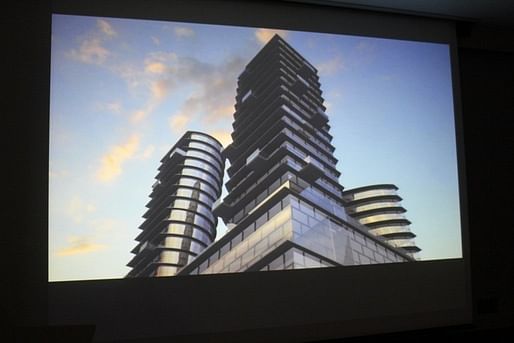
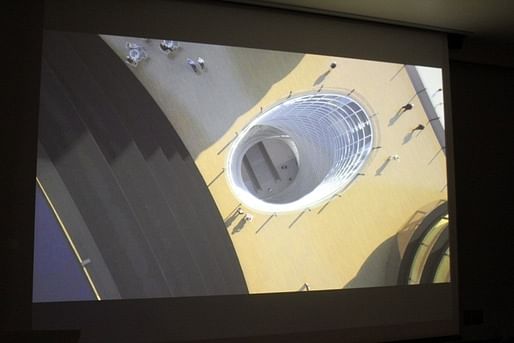
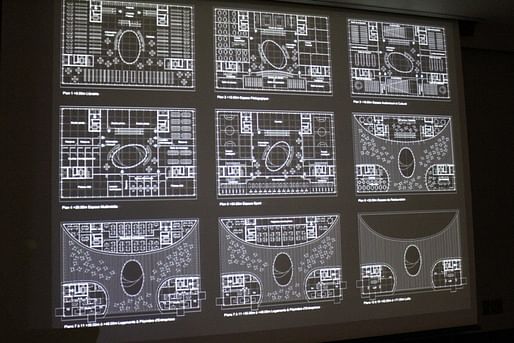
7:24: THM, Thermodynamic mixer. (GSD studio projects).
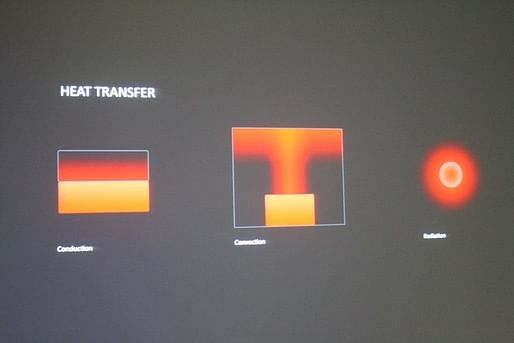
Nowadays in high-density cities, especially in Asian countries...this prototype can suggest a new organization of space. The difficulty of being an architect is that you go from project to project. ...But we (as a profession, I think he means) are unable to use simple ways to have certainty that we're (doing things right). The model allows a kind of visualization of heat gains; who needs grasshopper when you can understand these things visually, directly?
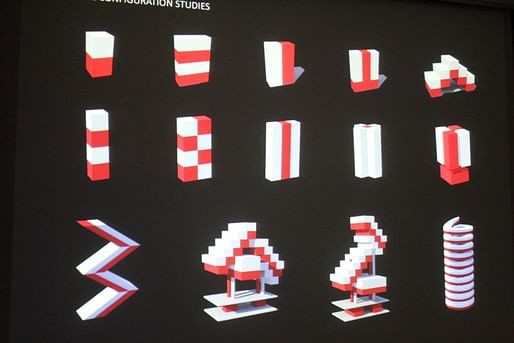 Aggregations of units.
Aggregations of units.
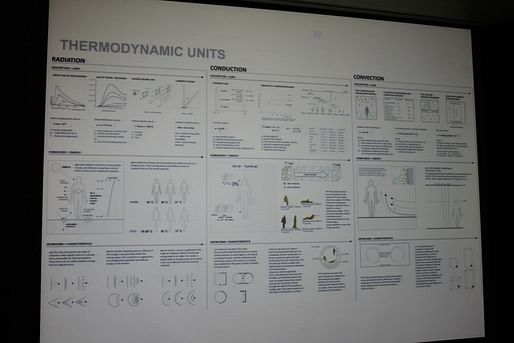



Many pages of thermodynamic studies by GSD students.
Converting everything into watts, to understand proportions of program and the energy it takes to heat or cool those spaces. "What began completely random became a way to criticize the absurd simplicities we have attached to the type of mixed use." It produces spatial transformations. These are prototypes developed exclusively through thermodynamic principles. "We forced students to renounce gravity, and tectonics. Thermodynamics was the only paradigm they had to be attached to." They called the projects "monsters."

"I (usually) hate these books, especially these books where there's student work and you can't understand anything on the page. If you have the time, I promise you can understand everything on these pages." Psychrometric charts--primitive, practical, and nobody understands them in architecture schools.

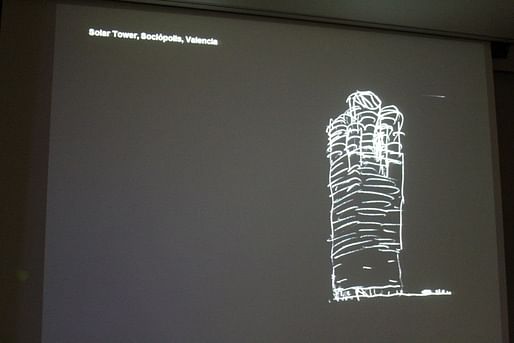
7:34: A building created without a site or client. Just an idea to morph two kinds of towers. Then a project in Valencia. Lots of politics about protecting farms, blending housing and farms. The project is compositional; they didn't want to make poor-looking towers; the top needs to be ornamental, evoking the fantasy of living in a wonderful world of terraces. Losing the Protestant image that social housing has to be sad and boring. "This, applied to social housing, increases the degree of difficulty enormously."
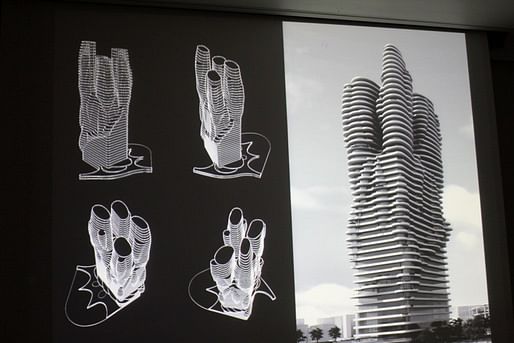
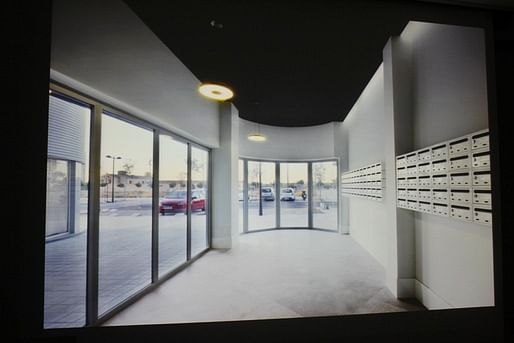
80% homogeneous and 20% compositional games.
Nobody pays for terraces--"a crime" given the climate in Valencia. If you make stepped buildings, the terraces are for free. Tricky things to gain a thermal balance. Towers also increase ventilation, which is the only way to escape the humidity. Note the long unit on the top left for cross-ventilation, and the one to the below-right of that, with its scalloped edge creating different views.

The loneliness of the building, surrounded by nothingness.
"And we are using this corrugated aluminum," because it's the only material that allows us to make bright, curved surfaces without economic penalty. Modest interiors, "but I think they have a dignity."
"I wanted to bring this social housing project after the thermodynamic prototypes," because it shows the pragmatic limits of projects.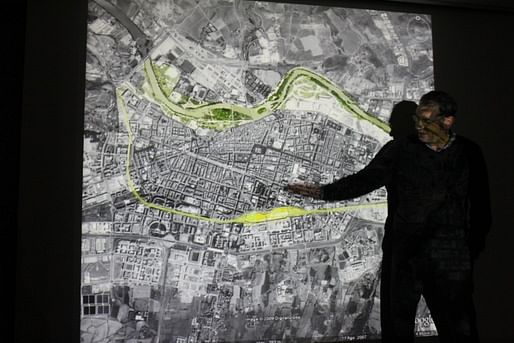
7:40: Another project. River and train station, which unifies the city and creates a new center. Created a hill instead of an object for the station. "Around we just made a kind of correct organization of residential typologies--north, south, etc." Just "A, B, Cs."
This is the image from the competition--the idea that the ambience of the city could change through these infrastructures. Simplest modeling tools for the geometry.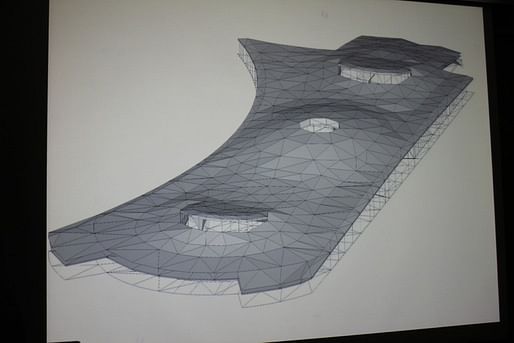
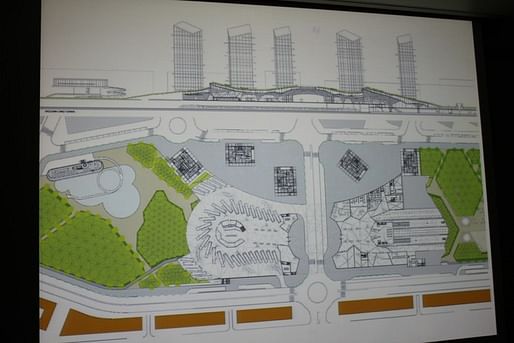
 The whole idea was to create a configuration that was similar below and above the roof--so the two programs, the public park and the station, could become a single system, that the citizens could use. We wanted to maintain the complexity of the structure and at the same time wrap it. So we used a system of lamellas that articulate as you move around.Mirrored lanterns that create patterns with light. A kind of constant ornament.
The whole idea was to create a configuration that was similar below and above the roof--so the two programs, the public park and the station, could become a single system, that the citizens could use. We wanted to maintain the complexity of the structure and at the same time wrap it. So we used a system of lamellas that articulate as you move around.Mirrored lanterns that create patterns with light. A kind of constant ornament.
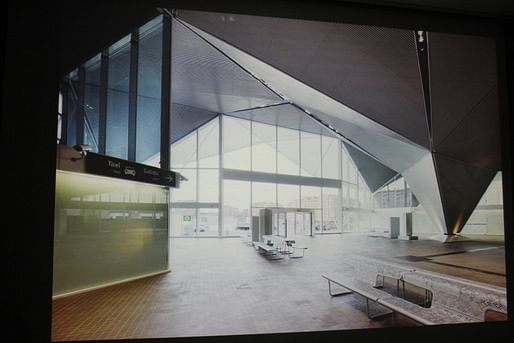

The geometry "isn't casual"--the columns are located where they can be, because the tracks are complex in their arrangement. "Goes without saying" that it works without air-conditioning 99% of the days.
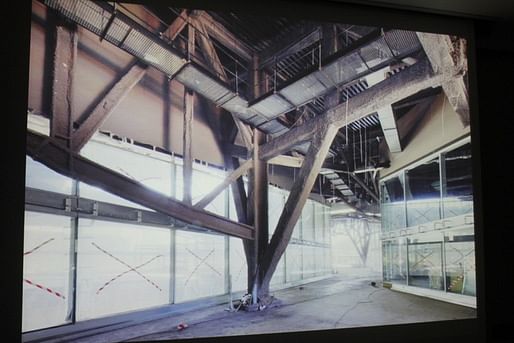
The station was the only one of the three projects commissioned to star architects that was on time and on budget. One of the others went 10x over budget. Referring to his project, IA says "it looks stupid, but" these things are not so easy.
End. Applause. "I don't know if this is a lecture on thermodynamics or on the limits of ideas."
7:48: Question about the columns--balance between performance and expression. IA: Doesn't see these as separate. "One thing you learn in practice is that you have to be really opportunistic." You have to study the conditions and find the opportunities. Sometimes all you can do is have your building "look like" they perform, which is useless. There are buildings that perform well and look normal, and they "don't change your life."
When we work metaphorically with the air in motion, we're very close to working technically in the correct way. "This is why I was insisting with the students that we ignore tectonics" within the studio projects.
In the Valencia project, "you can't imagine" how many constraints there were. The project hasn't paid a single Euro to receive any green certifications, but has received the highest commendation. It doesn't have any facades "painted in green" but it performs. So technical efficiency and expression need to be understood as an authentic dialectic in contemporary architecture.
7:53: Question about the metal wrap in the Valencia project. Looks nice but expensive; would like the project without it as well.
IA: You cannot leave the structure unprotected; it's sprayed with fire-resistant stuff and it's obliged by law. The screen is an extruded aluminum, and it gives a quality and homogeneity to the system. "Honestly, I thought they were not going to use it, but thanks to the crisis, it became exactly the same price as the cheapest aluminum system that you can destroy with your hands. This is what construction is about--finding opportunities."
Question: Between the performance of the building--the grotto and the lightwell; or in the Paris metro, the air movement and the lanterns. But in the studio projects, the idea of "pure knowledge" in architecture, lack some of the things that are most interesting in architecture.
IA: I would say no. I like a lot the way you present the discussion and the observation you have made. But for example--I think there is a similarity in how these projects are showing the interactions and optimizations with wind. And the science is "metaphors" more often than something like engineering. And the projects are "monsters," not architecture, because they're so literal and direct in their use of the metaphors.
Comments from Kiel: "Thesis in general--from the Dean on down," we want the thesis projects to become part of a larger research platform in the school, not just individual projects that go away after. So we want the thesis prep work and so on to lead to publications. Starting to construct a more specifically architectural agenda for these things. We've been borrowing the agendas of sustainability (from more technical fields) but this kind of work is building an architectural agenda.
There are going to be thesis groups, but also Energy, Environments, and Design Labs, and various funded research projects...from the scale of molecules to global Neo-Liberalism.
Done.
Thanks for reading!
Lian
This blog was most active from 2009-2013. Writing about my experiences and life at Harvard GSD started out as a way for me to process my experiences as an M.Arch.I student, and evolved into a record of the intellectual and cultural life of the Cambridge architecture (and to a lesser extent, design/technology) community, through live-blogs. These days, I work as a data storyteller (and blogger at Littldata.com) in San Francisco, and still post here once in a while.



No Comments
Block this user
Are you sure you want to block this user and hide all related comments throughout the site?
Archinect
This is your first comment on Archinect. Your comment will be visible once approved.